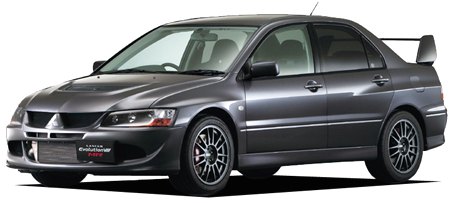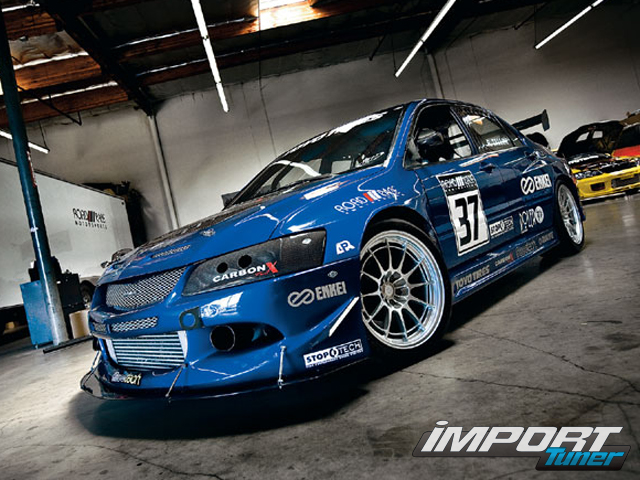The Mitsubishi Lancer Evolution VIII was modified again in 2003 this time sporting 17" grey Enkei wheels, Brembo Brakes and Bilstein shocks to handle traction and a 5-speed manual gearbox with 280 PS (202 kW; 276 hp)(approx. 234 hp to the wheels). Originally a one off model, sales were so successful in the U.S. that by 2005 it was available in four trims: the standard GSR model in Japan, the RS, 5-speed gearbox, and standard wheels (lacking excess components, such as interior map lights, power windows/doors, and radio), the SSL (with a sunroof, trunk mounted subwoofer, and leather seats), and the MR, which came with a revised limited-slip front differential, aluminum MR shift knob, handbrake with carbon fiber handle, 17 inch BBS wheels, aluminum roof, and a 6-speed manual gearbox. The new Evolution also sported chrome housing tail lights and head lights.
The Mitsubishi Lancer Evolution VIII MR uses slick-response Bilstein shocks for improved handling. The aluminium roof panel and other reductions in body weight have lowered the centre of gravity to produce more natural roll characteristics. Detail improvements have also been made to Mitsubishi's own electronic four-wheel drive, to the ACD 5 + Super AYC 6 traction control, and to the Sports ABS systems. The Lancer Evolution VIII displayed at the 2003 Tokyo Motor Show took the MR designation traditionally reserved for Mitsubishi Motors high-performance models (first used for the Galant GTO). Other parts on the MR include BBS alloy wheels, the aforementioned Bilstein shocks, and an aluminium roof. In the United Kingdom, many special Evolutions were introduced, including the FQ300, FQ320, FQ340, and FQ400 variants. They came with 305, 325, 345, and 405 hp (227, 239, 254 and 302 kW), respectively.
The FQ400, sold through Ralliart UK, produces 411 PS (302 kW; 405 hp) from its 2.0 L 4G63 engine, the result of special modifications by United Kingdom tuning firms Rampage Tuning, Owen Developments, and Flow Race Engines. At 202.9 hp (151.3 kW) per litre, it has one of the highest specific outputs per litre of any roadcar engine. With a curb weight of 1,450 kg (3,197 lb), it achieves 0–60 mph in 3.5 [9] seconds, 0–100 mph in 9.1 seconds, 1/4 mile in 12.1 seconds at 117 mph (188 km/h), and a top speed of 175 mph (282 km/h) while costing £48,000. BBC's television series Top Gear demonstrated that the stock FQ-400 could surprisingly keep up with a Lamborghini Murciélago around a test track. The Stig recorded a Top Gear Power Lap Times of 1 minute and 24.8 seconds (damp track), 1.1 seconds slower than the Murciélago's time of 1 minute 23.7 seconds.(dry track) In a similar test conducted by Evo magazine, the Evolution was able to lap the Bedford Autodrome faster than an Audi RS4 and a Porsche 911 Carrera 4S.
The Lancer Evolution VIII was also the first Evolution to be sold in the United States of America,spurred by the success of the Subaru Impreza WRX which had been released there just the year prior.[3] The Evolution VIII found its true competition in the Subaru Impreza WRX STI model the same year as the Evolution VIII's US introduction. With its 2.0 liter 271 horsepower engine, the 2003 Evolution VIII was capable of achieving a 0-100 km time of 5.1 seconds. However, the internal components for the American versions were largely stripped-down versions of the specifications for the Japanese Lancer Evolution VIII. No US-spec Evolution model prior to the Evo X has active yaw control, including the 2006 Evolution IX. The American 2003 and 2004 GSRs are without the helical limited-slip front differential and 6-speed manual transmission. The 2004 US spec RS models, however, do have a front helical limited-slip differential. All 2003, 2004 and 2005 RS and GSR models have the Japanese Evolution VII's 5-speed transmission. The MR edition was introduced to the US in 2005, with ACD and the only model with a 6-speed transmission. The 2005 US spec RS and GSR have the ACD standard, and the front helical limited-slip differential is now standard on all models. The boost, timing, and tuning are also significantly lower than its Japanese counterpart, allowing it to adhere to the strict emissions regulations of the United States. Starting in 2005, the US model Evos were also fitted with a 5500rpm limit on launching in 1st gear to protect the drivetrain.
Most Evolution VIIIs have a carbon fiber rear spoiler with matching body-color endplates.
Furthermore, the US versions of the Lancer Evolution VIII 2003–2005 were given bulkier rear bumpers than their Japanese counterparts to accommodate US safety laws in the form of the metal rear crash bar. All Evos have lightweight aluminum front fenders and hoods.
The basic RS Edition does not come with power windows, locks, or mirrors, an audio system, rear wing, sound deadening material, map lamps or an anti-lock braking system. All Evo VIII RS models sold in the US have an air conditioning system.

The 2005 MR/RS editions came with aluminum roof. Additionally, MR Editions come equipped with a 6-speed transmission, Bilstein shocks, Optional graphite grey color and factory optional BBS wheels. The MR Edition also received engine updates and reliability changes, the engine updates include larger turbo diameter mouth, updated cam profiles, lighter balance shafts and changed from single wastegate solenoid to dual solenoid. The reliability changes will be larger oil cooler core, ion coated piston rings, reinforced cylinder head and 5 layer head gasket compared to the 3 layer.[13]
- RS – "rally sport", revised 5-speed, minimal interior, LSD.
- MR RS – same as RS with 6-speed Manual Transmission.
- GSR – 5-speed, gauge pack, SAYC (Super Active Yaw Control).
- MR GSR – 6 speed transmission, Aluminium roof, BBS Wheels, Bilsteins, MR Badging, Optional graphite grey color, Vortex Generator, engine and reliability updates
| Eighth generation | |
|---|---|
| Overview | |
| Production | January 2003 – March 2005 |
| Body and chassis | |
| Platform | CT9A |
| Powertrain | |
| Transmission | 5-speed manual 6-speed manual |
| Dimensions | |
| Wheelbase | 2,625 mm (103.3 in) |
| Length | 4,490–4,535 mm (176.8–178.5 in) |
| Width | 1,770 mm (69.7 in) |
| Height | 1,450 mm (57.1 in) |
| Curb weight | 1,320–1,410 kg (2,910–3,109 lb) |
As the rally campaign had switched to WRC-spec machines which had less relevance to the road car, Mitsubishi could slower the pace of the Evo's development. Generation VIII arrived 2 years after the VII in Jan 2003, yet it was not a major upgrade. Style-wise, it could be easily distinguished from the old car by a new corporate grille and an extended front overhang which reserved space for an anti-intrusion bar required by US regulations. Extra ventilation holes were opened on the front bumper to feed the larger intercooler. In addition to modified exhaust and a more efficient turbocharger, the long-serving 4G63 motor produced another 7 lbft of torque at 289 lbft. Horsepower remained at 280, but most believed the actual figure should be 310. The big news was a new 6-speed close-ratio manual gearbox, which helped the new car to recoup the performance lost in Evo VII. The AYC active yaw control was upgraded to Super AYC, using planetary gear instead of bevel gears to double the amount of torque transfer allowed between rear wheels. As a result, the Evo VIII cornered even quicker than Evo VII. It steering became even shaper, without understeer even approaching its cornering limit.
 Feb 2004 saw the release of Evo
VIII MR, whose name meant "Minor Revision" – no, actually
"Mitsubishi Racing". Its turbocharging system was tuned to deliver
stronger high-rev output (though still quoted 280 hp) and a little more
torque again. Some weight saving measures cut 10 kilos from the kerb
weight. In particular, the roof was made in aluminum to lower center of
gravity. Bilstein dampers improved ride a little. The ACD and AYC were
reprogrammed to intrude less with ABS. Exterior remained unchanged
though.
Feb 2004 saw the release of Evo
VIII MR, whose name meant "Minor Revision" – no, actually
"Mitsubishi Racing". Its turbocharging system was tuned to deliver
stronger high-rev output (though still quoted 280 hp) and a little more
torque again. Some weight saving measures cut 10 kilos from the kerb
weight. In particular, the roof was made in aluminum to lower center of
gravity. Bilstein dampers improved ride a little. The ACD and AYC were
reprogrammed to intrude less with ABS. Exterior remained unchanged
though.
No comments:
Post a Comment